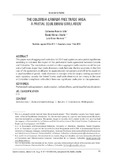Mostrar el registro sencillo del ítem
The colombia-canada free trade area: a partial equilibrium simulation
| dc.creator | Pereira Villa, Catherine | spa |
| dc.creator | Gómez Abella, Daniel | spa |
| dc.creator | Herrera, Luis Omar | spa |
| dc.date.accessioned | 2014-10-22T20:09:33Z | spa |
| dc.date.available | 2014-10-22T20:09:33Z | spa |
| dc.date.created | 2012-06-30 | |
| dc.identifier | http://revistas.udem.edu.co/index.php/economico/article/view/386 | spa |
| dc.identifier.uri | http://hdl.handle.net/11407/996 | |
| dc.description | This paper uses disaggregated trade data for 2010 and applies ex-ante partial equilibriummodeling to calculate the impact of the preferential trade agreement between Canadaand Colombia. The simulations carried out show aggregate trade creation could be oneand a half times larger than trade diversion; trade between the two countries in the firstyear of the agreement could grow by approximately ten percent and will be focussed ona small number of goods; trade diversion is stronger with the largest trading partner ofeach signatory, namely the United States; and trade diversion is not strong in the caseof Colombia’s neighbors with which there was significant trade prior to the agreement | spa |
| dc.format.mimetype | application/pdf | |
| dc.language.iso | spa | |
| dc.publisher | Universidad de Medellín | spa |
| dc.relation | http://revistas.udem.edu.co/index.php/economico/article/view/386/344 | spa |
| dc.rights | Copyright (c) 2014 Semestre Económico | spa |
| dc.rights.uri | http://creativecommons.org/licenses/by-nc-sa/4.0/ | * |
| dc.source | Semestre Económico; Vol. 15, núm. 31 (2012); 15-42 | spa |
| dc.source | 2248-4345 | spa |
| dc.source | 0120-6346 | spa |
| dc.subject | Preferential trade agreement | spa |
| dc.subject | trade creation | spa |
| dc.subject | welfare effects | spa |
| dc.subject | partial equilibrium simulation | spa |
| dc.title | The colombia-canada free trade area: a partial equilibrium simulation | spa |
| dc.type | Article | eng |
| dc.type.version | info:eu-repo/semantics/publishedVersion | |
| dc.type.driver | info:eu-repo/semantics/article |



